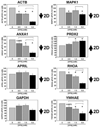Proteomic analysis of peripheral leukocytes in Alzheimer's disease patients treated with divalproex sodium
- PMID: 17521776
- PMCID: PMC2621111
- DOI: 10.1016/j.neurobiolaging.2007.04.004
Proteomic analysis of peripheral leukocytes in Alzheimer's disease patients treated with divalproex sodium
Abstract
The molecular profiling of peripheral tissues, including circulating leukocytes, may hold promise in the discovery of biomarkers for diagnosing and treating neurodegenerative diseases, including Alzheimer's disease (AD). As a proof-of-concept, we performed a proteomics study on peripheral leukocytes from patients with AD both before and during treatment with divalproex sodium. Using two-dimensional gel electrophoresis and MALDI-TOF mass spectrometry, we identified 10 differentially expressed proteins: two up-regulated proteins, 14-3-3 protein epsilon and peroxiredoxin 2; and eight down-regulated proteins, actin-interacting protein, mitogen activated protein kinase 1, beta actin, annexin A1, glyceraldehyde 3-phosphate dehydrogenase, transforming protein RhoA, acidic leucine-rich nuclear phosphoprotein 32 family member B, and a currently unidentified protein. A subset was validated on both the transcript and protein levels in normal human peripheral blood mononuclear cell cultures treated with valproic acid. These proteins comprise a number of functional classes that may be important to the biology of AD and to the therapeutic action of valproate. These data also suggest the potential of using peripheral leukocytes to monitor pharmaceutical action for neurodegenerative diseases.
Figures




Similar articles
-
A randomized, double-blind, placebo-controlled pilot trial of safety and tolerability of two doses of divalproex sodium in outpatients with probable Alzheimer's disease.Curr Alzheimer Res. 2005 Dec;2(5):553-8. doi: 10.2174/156720505774932205. Curr Alzheimer Res. 2005. PMID: 16375658 Clinical Trial.
-
Proteomic profiling of brain cortex tissues in a Tau transgenic mouse model of Alzheimer's disease.Biochem Biophys Res Commun. 2013 Jan 11;430(2):670-5. doi: 10.1016/j.bbrc.2012.11.093. Epub 2012 Dec 2. Biochem Biophys Res Commun. 2013. PMID: 23211594
-
Plasma protein profiling for potential biomarkers in the early diagnosis of Alzheimer's disease.Neurol Res. 2017 Mar;39(3):231-238. doi: 10.1080/01616412.2017.1281195. Epub 2017 Jan 20. Neurol Res. 2017. PMID: 28107809
-
Impaired autophagy and APP processing in Alzheimer's disease: The potential role of Beclin 1 interactome.Prog Neurobiol. 2013 Jul-Aug;106-107:33-54. doi: 10.1016/j.pneurobio.2013.06.002. Epub 2013 Jul 1. Prog Neurobiol. 2013. PMID: 23827971 Review.
-
Proteomic landscape of Alzheimer's Disease: novel insights into pathogenesis and biomarker discovery.Mol Neurodegener. 2021 Aug 12;16(1):55. doi: 10.1186/s13024-021-00474-z. Mol Neurodegener. 2021. PMID: 34384464 Free PMC article. Review.
Cited by
-
New treatment strategies for Alzheimer's disease: is there a hope?Indian J Med Res. 2013 Oct;138(4):449-60. Indian J Med Res. 2013. PMID: 24434253 Free PMC article. Review.
-
Mass spectrometry-based proteomics in Chest Medicine, Gerontology, and Nephrology: subgroups omics for personalized medicine.Biomedicine (Taipei). 2014;4(4):25. doi: 10.7603/s40681-014-0025-y. Epub 2014 Nov 13. Biomedicine (Taipei). 2014. PMID: 25520938 Free PMC article.
-
Nanoparticle-Enabled Enrichment of Longitudinal Blood Proteomic Fingerprints in Alzheimer's Disease.ACS Nano. 2021 Apr 27;15(4):7357-7369. doi: 10.1021/acsnano.1c00658. Epub 2021 Mar 17. ACS Nano. 2021. PMID: 33730479 Free PMC article.
-
Chipping away at diagnostics for neurodegenerative diseases.Neurobiol Dis. 2009 Aug;35(2):148-56. doi: 10.1016/j.nbd.2009.02.016. Epub 2009 Mar 10. Neurobiol Dis. 2009. PMID: 19285134 Free PMC article. Review.
-
Improved control of tuberculosis and activation of macrophages in mice lacking protein kinase R.PLoS One. 2012;7(2):e30512. doi: 10.1371/journal.pone.0030512. Epub 2012 Feb 16. PLoS One. 2012. PMID: 22359543 Free PMC article.
References
-
- Blandini F, Sinforiani E, Pacchetti C, Samuele A, Bazzini E, Zangaglia R, Nappi G, Martignoni E. Peripheral proteasome and caspase activity in Parkinson disease and Alzheimer disease. Neurology. 2006;66:529–534. - PubMed
-
- Blum-Degen D, Frolich L, Hoyer S, Riederer P. Altered regulation of brain glucose metabolism as a cause of neurodegenerative disorders? 46. 1995:139–147. - PubMed
-
- Bradbury CA, Khanim FL, Hayden R, Bunce CM, White DA, Drayson MT, Craddock C, Turner BM. Histone deacetylases in acute myeloid leukaemia show a distinctive pattern of expression that changes selectively in response to deacetylase inhibitors. Leukemia. 2005;19:1751–1759. - PubMed
-
- Casademont J, Miro O, Rodriguez-Santiago B, Viedma P, Blesa R, Cardellach F. Cholinesterase inhibitor rivastigmine enhance the mitochondrial electron transport chain in lymphocytes of patients with Alzheimer's disease. J Neurol Sci. 2003;206:23–26. - PubMed
Publication types
MeSH terms
Substances
Grants and funding
LinkOut - more resources
Full Text Sources
Medical
Research Materials

